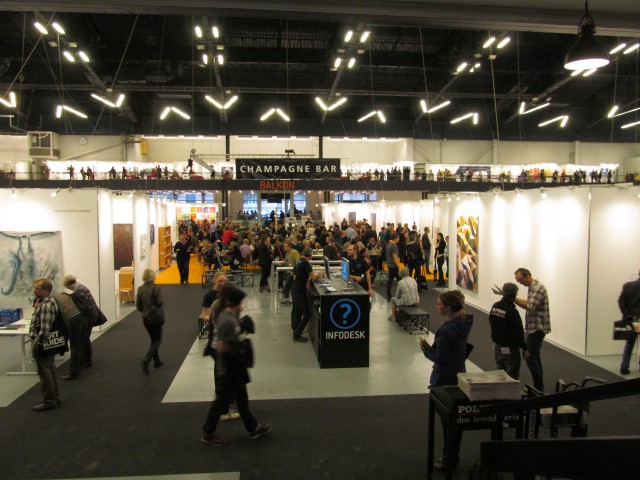There’s no escaping New York. Ten minutes after arriving at Art Copenhagen on Sunday, we encountered our boss Paddy Johnson’s face in William Powhida’s Cosmology (2010), a zodiac chart dividing New York art world figures into destroyers, saints, and so forth, with captions describing their roles.
We asked Gallery Poulsen owner Morten Poulsen whether Art Copenhagen fair-goers get the insider jokes from a foreign art world. Most people don’t, he said, but he encourages his collectors “to do their homework.” Should they?
Poulsen thinks so, and like many of the dealers we spoke with, he finds Danish collectors to be overwhelmingly conservative. That might be why most of Art Copenhagen looks like an explosion of figuration. Even Nils Staerk, which has a show by Brooklyn-based artist Matthew Ronay at their Carlsberg gallery, brought a smattering of straightforward figurative work to the fair. Poulsen mentioned how his artists would have been “way too figurative” to get into the more austere and abstract aesthetic of this year’s NADA New York.
So why the difference in taste? Part of that might lie in the desire for the market to swing back to an era before the Lehman Brothers crash, when, Poulsen told us, it seemed like the more decadent work sold all the better. “Back in 2007-2008, you had dicks and pussies just hanging out of the art. I sold 300 paintings with pussies and skulls because that’s what people wanted: sex and death. But it’s coming back,” he assured us. “And it will come back.”
If dicks indicate a market upswing, then Poulsen, along with a handful of other galleries, were optimistic. Looking around Art Copenhagen now, though, it seems the market mainly desires repurposed commercial packaging, gimmicky twists on figurative sculpture, and the same solid base of middling painting it always has. Basically, it looks like an art fair.
So what’s preventing the city’s only art fair from taking off? The fair has been around since 1997, but with most of its booths populated by Copenhagen galleries, the work ends up catering to that conservative local market. The biggest roadblock to the fair’s growth lies with the city’s most international galleries; Galleri Nicolai Wallner and Andersen’s Contemporary, which represent artists like Elmgreen & Dragset and Olafur Eliasson, respectively, both sit out the fair. Without those galleries, and the buyers they would inevitably bring, the fair misses out on an opportunity to grow its profile and its profit margins.
We got a curious set of responses from many dealers who told us Art Copenhagen “isn’t about selling.” A few, like Stockholm-based Galleri Andersson/Sandström, mentioned that they come back every year to connect with Danish collectors. Locals like David Risley partly came to connect with international collectors. Bo Bjerggaard of Galleri Bo Bjerggaard, one of Copenhagen’s most established modern and contemporary galleries, and which represents Jonathan Meese and Per Kirkeby, noted that sales were strong, but nothing out of the ordinary. Primarily, he said, it’s a community event.
The best way to gauge Art Copenhagen’s future might lie in this year’s more international and curated direction taken by the fair’s committee. At this installment, eighteen galleries were invited to present curated solo exhibitions; it’s a small gesture, but one that makes a large difference in giving off the appearance of insight and forethought, qualities not usually associated with an art fair. Geoff Newton, director of Neon Parc, a gallery out of Melbourne, Australia, was one of those invitation-only participants. It was his first time at Art Copenhagen, and he took a more considered approach, bringing Elizabeth Newman’s pared-down collage, in part because it resonates with Danish design. Newton reported that visitors described his booth as a “breath of fresh air.” It was. Maybe the work looked more like something we’d see at NADA, but here it was a break from the mold, and it’s the type of thing that could easily draw more international attention to the fair and its smattering of Danish artists—if that’s something it wants.



Comments on this entry are closed.